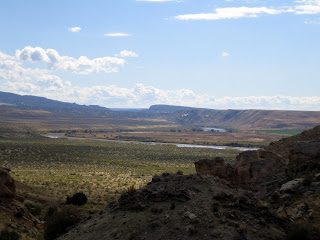
We spent the night at Mariposa Lodge, a lovely bed & breakfast in the western Colorado ski resort town of Steamboat Springs. On Monday morning we did a quick tour of the town & ski area then headed west again on Hwy 40. Just over the Colorado/Utah border we made a stop at Dinosaur National Monument. This 200,000 acre national park contains the largest number of Jurassic period dinosaur bones ever discovered.
In 1909, palaeontologist Earl Douglass found 8 segments of the tail of an Apatosauras (aka Brontosaurus) at the top of a steep sandstone cliff. Over 350 tons of plant and animal fossils including some full skeltons were excavated in the early years. Declared a national monument in 1915, fossils are still being extracted from this area today.

The visitors center at the park looks like it is growing out of the mountainside because it is! One entire wall of the center is comprised of a natural rock face still embedded with 1500 exposed dinosaur fossils. Unfortunately, the visitor center is currently closed because of subsidence of the unstable ground on which the building sits. However, there are other places in the park where exposed fossils can still be viewed in the rock faces, so Mark and I set off on a short hike to see them.
 Scientists believe that about 150 millons years ago the area was a river basin frequented by dinosaurs. Dinosaurs that died near the river or were caught in floods were swept downstream, caught on sandbars and were covered by subsequent layers of sand and mud, that compressed to form sedimentary rock and sandstone. About 65 million years ago those layers were gradually uplifted and slowly eroded to reveal the rock faces we can see today.
Scientists believe that about 150 millons years ago the area was a river basin frequented by dinosaurs. Dinosaurs that died near the river or were caught in floods were swept downstream, caught on sandbars and were covered by subsequent layers of sand and mud, that compressed to form sedimentary rock and sandstone. About 65 million years ago those layers were gradually uplifted and slowly eroded to reveal the rock faces we can see today.

In the center of the pic above, you can see the exposed fossil of dinosaur vertabrae or backbone.

Further along the rock face lies this exposed femur (leg) bone. Eleven different species of dinosuars have been found in this rock formation including apatosaurus, stegosaurus, allosaurus, certaosaurus and diplodocus.
 Today the area is again a part of a river basin. Here's a view from the dinosaur quarry down over the Green River Valley.
Today the area is again a part of a river basin. Here's a view from the dinosaur quarry down over the Green River Valley.
 The sandstone rock faces in the park also contain numerous petroglyphs left by the Freemont indians approx 1000 years ago. In the pic above there's a elk-like creature just off my right shoulder and a basket or head-piece high above my head.
The sandstone rock faces in the park also contain numerous petroglyphs left by the Freemont indians approx 1000 years ago. In the pic above there's a elk-like creature just off my right shoulder and a basket or head-piece high above my head.

After a short stop for lunch in Vernal, we headed home through Heber Valley to find that Mt Timpanogos had received its first snowfall for the season.
 We haven't been up to much of interest lately, so today Mark & I headed up nearby American Fork Canyon for some exercise and fresh air. We did a short hike along Tibble Fork Reservoir. This 13 acre reservoir is a popular fishing and camping spot. There was quite a bit of glare coming off the lake in the late afternoon sun. This shot is looking south down the reservoir towards Mt Timpanogos.
We haven't been up to much of interest lately, so today Mark & I headed up nearby American Fork Canyon for some exercise and fresh air. We did a short hike along Tibble Fork Reservoir. This 13 acre reservoir is a popular fishing and camping spot. There was quite a bit of glare coming off the lake in the late afternoon sun. This shot is looking south down the reservoir towards Mt Timpanogos.






































